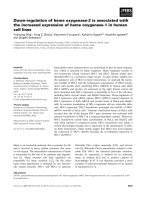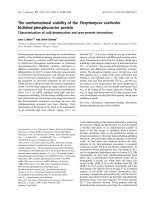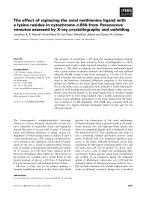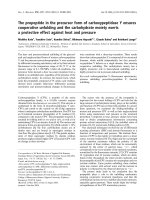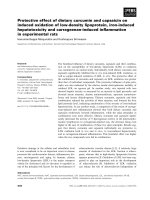Báo cáo khoa học: The effect of heme on the conformational stability of micro-myoglobin doc
Bạn đang xem bản rút gọn của tài liệu. Xem và tải ngay bản đầy đủ của tài liệu tại đây (768.28 KB, 8 trang )
The effect of heme on the conformational stability
of micro-myoglobin
Hong-Fang Ji
1,2
, Liang Shen
1,2
, Rita Grandori
3
and Norbert Mu
¨
ller
2
1 Shandong Provincial Research Center for Bioinformatic Engineering and Technique, Center for Advanced Study,
Shandong University of Technology, Zibo, China
2 Institute of Organic Chemistry, Johannes Kepler University, Linz, Austria
3 Dipartimento di Biotecnologie e Bioscienze, Universita degli Studi di Milano-Bicocca, Milan, Italy
The monomeric heme protein myoglobin (Mb) is
found mainly in muscle tissue [1], where its principal
physiological functions are oxygen storage and the
facilitation of oxygen transport to the mitochondria
for oxidative phosphorylation [2,3]. The capability of
Mb to bind oxygen depends on the presence of a heme
prosthetic group, in which an iron(II) cation is che-
lated by the four nitrogen atoms in the center of a
protoporphyrin ring. The metal ion can form two
additional coordinative bonds on either side of the
heme plane, termed the fifth and sixth coordination
positions, which are essential for the three-dimensional
structure and oxygen-binding function of the protein.
Mb folds into a globular, single-domain structure
with a high a-helix content. It comprises eight right-
handed a-helices (A–H, from the N- to C-terminus),
which are linked to each other by short loop regions
(Fig. 1) [4].
It has long been recognized that the central portion
of the globin fold (mid-helix B to mid-helix G) forms a
compact subdomain containing almost all the protein–
heme contact sites [5]. Recent studies have indicated
that a fragment corresponding to such a portion of the
structure is capable of folding into a functional heme-
binding unit forming a complex with the prosthetic
group with characteristics similar to native Mb [6,7].
The deletion product was subcloned and expressed as
a 77-amino-acid fragment spanning residues 29–105 of
sperm whale Mb, and was named micro-myoglobin
(lMb) [6]. The earlier experimental studies revealed
that, in the absence of heme, this fragment is mostly
disordered, but acquires a native-like a-helix content
on interaction with the cofactor [6]. (We note here that
‘native-like’ in the context of this paper refers to the
native fold of holo-Mb.) Holo-lMb, nevertheless, is
difficult to characterize experimentally as it has been
Keywords
heme binding; micro-myoglobin; molecular
dynamics simulation; protein stability;
unfolding
Correspondence
N. Mu
¨
ller, Institute of Organic Chemistry,
Johannes Kepler University, 4040 Linz,
Austria
Fax: +43 732 2468 8747
Tel: +43 732 2468 8746
E-mail:
(Received 28 May 2007, revised 29 October
2007, accepted 5 November 2007)
doi:10.1111/j.1742-4658.2007.06176.x
Micro-myoglobin, the isolated heme-binding subdomain of myoglobin, is a
valuable model system for the investigation of heme recognition and bind-
ing by proteins, and provides an example of protein folding induced by co-
factor binding. Theoretical studies by molecular dynamics simulations on
apo- and holo-micro-myoglobin show that, by contrast with the case of the
full-length wild-type protein and in agreement with earlier experimental evi-
dence, the apo-protein is not stably folded in a native-like conformation.
With the cofactor bound, however, the protein fragment maintains its
folded conformation over 1.5 ns in molecular dynamics simulations. Fur-
ther inspection of the model structures reveals that the role of heme in sta-
bilizing the folded state is not only a result of its direct interactions with
binding residues (His93, Arg45 and Lys96), but also derives from its shield-
ing effect on a long-range electrostatic interaction between Arg45 and
Asp60, which, in the molecular dynamics simulations, apparently triggers
the unfolding process of apo-micro-myoglobin.
Abbreviations
Mb, myoglobin; MD, molecular dynamics; PDB, Protein Data Bank; lMb, micro-myoglobin.
FEBS Journal 275 (2008) 89–96 ª 2007 The Authors Journal compilation ª 2007 FEBS 89
found to be prone to aggregation and precipitation at
high concentration. By contrast, a longer Mb-derived
fragment, spanning residues 32–139, and named mini-
myoglobin (mini-Mb), is capable of independent fold-
ing into a native-like conformation, even in the
absence of heme [8]. Other deletion products and circu-
lar permutations have also shown that the structural
determinants for heme binding can be segregated from
those for protein stability and solubility [9]. Thus,
lMb represents a valuable and, so far, unique model
system for the investigation of heme recognition by
proteins and its possible role as a structural scaffold
for the minimal heme-binding subdomain.
Molecular dynamics (MD) simulations can aid in
the understanding of the physical basis of the struc-
tural and functional features of biological macromole-
cules by providing details concerning intra- and
intermolecular motions as a function of time.
Although results of MD simulations do not always
and easily translate to assessment of conformational
stability in a thermodynamic sense, they can be used
to address specific questions about the properties of a
model system, particularly for comparison of mole-
cular variants under controlled conditions. Although
finding the thermodynamically most stable form of a
multiparticle system (and proving it) through MD
alone is generally impossible, instability revealed in
MD simulations is more straightforward to interpret
[10]. In this study, we performed MD simulations on
‘heme-excised’ apo-lMb and holo-lMb with the fol-
lowing aims: (a) to compare the stability of native-like
structural models for apo-lMb and holo-lMb; (b) to
investigate the mechanisms by which heme affects
protein conformation and dynamics; and (c) to probe
the transitions of each individual helix during the ini-
tial step of thermal unfolding.
Results and Discussion
Apo-lMb
Snapshots of the MD simulation trajectory of apo-
lMb at 0.0, 0.25, 0.5, 0.75, 1.0, 1.25 and 1.5 ns have
been extracted and visualized in Fig. 2 by ribbon
Fig. 1. Ribbon representation of the crystallographic structure of
sperm whale myoglobin. The eight helices of the myoglobin fold
are labeled A–H from the N- to C-terminus (PDB entry 1A6N).
Fig. 2. Snapshots of apo-lMb (residues 29–105) and holo-lMb
simulations extracted from the MD trajectories at 400 K. Red,
a-helix; green, random coil.
Stability of micro-myoglobin H F. Ji et al.
90 FEBS Journal 275 (2008) 89–96 ª 2007 The Authors Journal compilation ª 2007 FEBS
drawings. It can be seen that apo-lMb quickly moves
away from the initial native-like conformation, i.e. it
unfolds easily over the timescale of the simulation.
Therefore, we can conclude that the native-like fold is
not even a metastable conformation of this protein. To
compare the unfolding of the individual helices of apo-
lMb, the average rmsd of each helix after 1.5 ns of
simulation was calculated over the backbone atoms
relative to the initial energy-minimized conformation.
The values are 1.87 A
˚
for helix B, 1.95 A
˚
for helix C,
1.69 A
˚
for helix D, 5.23 A
˚
for helix E, 1.92 A
˚
for helix
F and 2.07 A
˚
for helix G. A close look at Fig. 2
reveals that helix G is the first to unfold, which is
understandable because it spans only five residues
despite its relatively low rmsd (2.07 A
˚
). However, it is
interesting to find that, although helix E is the longest
and is positioned close to the core of the sequence, it
is the second to unfold, immediately following helix G,
as indicated in Fig. 2. This stimulated us to further
inspect the unfolding process of helix E. Previous
investigations on native apo-Mb have indicated that
helix E is the first to unfold (or the last to fold)
[11,12]. However, according to the present study in
apo-lMb, helix G unfolds first. This difference may
Fig. 3. Variation of hydrogen-bond distances
in helix E during the 1.5 ns simulation of
apo-lMb at 400 K. The distances are mea-
sured between CO(i) and NH(i+4), where
i ranges from residue 58 to residue 73.
H F. Ji et al. Stability of micro-myoglobin
FEBS Journal 275 (2008) 89–96 ª 2007 The Authors Journal compilation ª 2007 FEBS 91
arise from the fact that helix G is truncated in lMb,
which allows it to unfold faster than helix E, which is
complete in the fragment. It should be noted, however,
that helix F has been found to be disordered in native
apo-Mb under neutral and equilibrium conditions [13].
A close look at Fig. 2 reveals that helix E of apo-
lMb begins to unfold from its N-terminus at 0.5 ns,
and approximately one-half of the helix is disordered
at 1.0 ns. Within the first 1.5 ns, helix E disappears
completely. To describe helix E unfolding, 14 hydro-
gen-bond distances [CO(i)–NH( i + 4)] that character-
ize the a-helix between residues 58 and 77 were
tracked throughout the MD simulation (Fig. 3).
The first hydrogen bond that breaks is that between
CO(60) and NH(64), at the N-terminus of the helix.
Starting at 0.3 ns, the CO(60)–NH(64) distance begins
to increase, reaching 6.0 A
˚
at 0.4 ns, clearly indicating
that this hydrogen bond no longer exists. Subse-
quently, significant fluctuations in the distances of
other hydrogen bonds are observed. The CO(61)–
NH(65) and CO(62)–NH(66) hydrogen-bond distances
start to increase at 0.5 and 0.7 ns, respectively, which
is accompanied by a further increase in the distance
between CO(60) and NH(64). Subsequent break-up of
all the other hydrogen bonds within helix E ultimately
results in complete unfolding of this helix.
Further inspection of the unfolding snapshots of
model structures of apo-lMb reveals that, during the
unfolding simulation, the distance between the carbox-
ylate oxygen of Asp60 (helix E) and the imino nitrogen
of Arg45 (helix C) decreases rapidly from 8.0 to 3.0 A
˚
.
This can be interpreted as the formation of a salt
bridge between these two residues (Figs 4 and 5). The
occurrence of a salt bridge at approximately 0.5 ns
coincides with the beginning of the unfolding of
helix E described above (Fig. 2). Therefore, the forma-
tion of this salt bridge between Arg45 and Asp60
seems to play an important role in triggering apo-lMb
unfolding.
Previous experimental studies have shown that apo-
lMb has a disordered conformation in aqueous solu-
tion at ambient temperature in the absence of heme
[6], whereas, under the same conditions, the full-
length apo-protein can fold into a native-like confor-
mation and pre-organize the heme pocket before
making contact with the cofactor [13]. For compari-
son, MD simulations were also performed on ‘heme-
excised’ apo-Mb, under the same conditions and
initial assumptions as for apo-lMb. The average
backbone rmsd for apo-Mb compared with the initial
energy-minimized conformation is 3.51 A
˚
, much lower
than that for apo-lMb: 4.99 A
˚
(Fig. 6). These data
corroborate the effectiveness of MD simulations in
Fig. 4. Variation of distances between the amino nitrogen of Arg45
and the carboxylate oxygen of Asp60 during the 1.5 ns simulation
of apo-lMb (residues 29–105).
Fig. 6. Evolution of backbone rmsd during the 1.5 ns simulation of
apo-lMb, ‘heme-excised’ apo-Mb and holo-lMb at 400 K, relative
to the respective initial structures.
Fig. 5. Three-dimensional model of the salt bridge between Arg45
and Asp60 in apo-lMb based on the structure at approximately
0.5 ns of the simulation.
Stability of micro-myoglobin H F. Ji et al.
92 FEBS Journal 275 (2008) 89–96 ª 2007 The Authors Journal compilation ª 2007 FEBS
discriminating between stable and unstable protein
conformations. Thus, in agreement with the experi-
mental evidence [6], the results presented here show
that a native-like Mb conformation does not repre-
sent a stable state for the truncated lMb fragment in
the absence of heme.
A comparison of the dynamics of helix E, in par-
ticular between apo-Mb and apo-lMb, also shows
considerable differences. The backbone rmsd between
the starting and final structures of the fragment corre-
sponding to helix E is 3.18 A
˚
for apo-Mb and 5.23 A
˚
for apo-lMb. Inspection of the Mb structure indi-
cates that, in apo-Mb, helix E is stabilized by several
salt bridges formed between helix E side-chains and
neighboring residues from helices A and B (Fig. 7),
such as Glu4-Lys79, Glu18-Lys77 and Asp27-Lys56,
as also pointed out in a previous study [14]. The sta-
bilizing effect of these salt bridges in apo-Mb pre-
vents fluctuations at the N-terminus of helix E, and
apparently also retards the formation of the salt
bridge between Asp60 and Arg45, which is an impor-
tant factor triggering apo-Mb unfolding. By contrast,
these salt bridges are absent in apo-lMb because of
the absence of the helices A and B, providing a possi-
ble explanation for the distinct behavior of helix E in
apo-lMb and apo-Mb.
Holo-lMb
In order to investigate the role of heme in protein
dynamics and stability, MD simulations were per-
formed on holo-lMb under the same conditions as
employed for apo-lMb. In Fig. 2, the extracted snap-
shots of holo-lMb simulation are shown juxtaposi-
tioned to the corresponding positions of apo-lMb. It
is evident that the holo-protein displays much reduced
dynamics. By contrast with the almost unfolded struc-
ture of apo-lMb at the end of the simulation, most
helices of holo-lMb are still folded at the end of the
simulation period. This remarkably different behavior
of the protein in the presence and absence of heme is
also reflected by the respective rmsd values from a
comparison of the backbone conformations before and
after the MD simulation runs, which are 3.28 A
˚
for
holo-lMb and 4.99 A
˚
for apo-lMb (Fig. 6).
These findings provide some clues for the interpreta-
tion of the experimental result that apo-lMb is almost
unfolded [6], whereas the same fragment folds into a
predominantly a-helical secondary structure on interac-
tion with heme, thus forming a complex with the pros-
thetic group with characteristics similar to the fold of
native holo-Mb. According to the crystal structure of
holo-Mb [15], the heme ligand allows for coordination
interaction between the iron ion and an imidazole ring
nitrogen of His93, and its propionate groups are
engaged in salt bridges with the basic side-chains of
Arg45 and Lys96 (Fig. 8). These interactions conceiv-
ably also contribute to the conformational stability of
holo-lMb. Consistently, they are maintained over the
1.5 ns of the simulation (Fig. 2).
A comparison of the hydrogen-bond distances in
Figs 3 and 9 indicates that helix E also displays
reduced dynamics in holo-lMb relative to its counter-
part in apo-lMb. As mentioned above, in apo-lMb,
Arg45 forms a salt bridge with Asp60 in the first
0.5 ns of MD simulation, triggering the unfolding of
helix E and the subsequent global unfolding of the
structure. In holo-lMb, the shielding effect of the
heme and the engagement of Arg45 in the salt bridge
Fig. 7. Three-dimensional model of salt bridges Glu4-Lys79, Glu18-
Lys77 and Asp27-Lys56 in apo-Mb (PDB entry 1A6N).
Fig. 8. Three-dimensional model of the salt bridges made by Arg45
and Lys96 with the two propionate groups of heme in holo-lMb.
H F. Ji et al. Stability of micro-myoglobin
FEBS Journal 275 (2008) 89–96 ª 2007 The Authors Journal compilation ª 2007 FEBS 93
with the heme propionate prevent the build-up of
attractive electrostatic interactions between Arg45 and
Asp60 that are seen to lead to apo-lMb unfolding.
Therefore, in addition to direct interaction with bind-
ing residues, heme seems to stabilize the lMb folded
state also by counteracting long-range electrostatic
interactions that would otherwise act as destabilizing
forces for native-like conformations.
Conclusions
The comparison of apo- and holo-lMb by MD simu-
lations reveals a dramatic effect of the heme cofactor,
which is seen to stabilize native Mb-like folded confor-
mations of the protein fragment, in agreement with the
available experimental evidence. The simulation results
suggest that, in the absence of heme, the unfolding
process is triggered by the formation of a non-native
salt bridge between Arg45 and Asp60. The presence of
heme at the active site counteracts this unfolding
mechanism, in addition to providing stabilizing inter-
actions with the folded chain per se. Although the
starting conformation used here for apo-lMb simula-
tion has not been observed experimentally, it can be
taken as a model of an unstable intermediate in holo-
lMb unfolding on loss of the cofactor. The MD simu-
lation results provide an explanation of why such a
conformation is not a stable state for apo-lMb.
Electrostatic interactions, in general, have attracted
considerable interest in protein folding studies, as it
has been shown that surface charges can play an
important role in protein stability [16]. Nevertheless,
Fig. 9. Variation of hydrogen-bond distances
in helix E during the 1.5 ns simulation of
holo-lMb at 400 K. The distances are
between CO(i) and NH(i+4), where
i ranges from residue 58 to residue 73.
Stability of micro-myoglobin H F. Ji et al.
94 FEBS Journal 275 (2008) 89–96 ª 2007 The Authors Journal compilation ª 2007 FEBS
the contribution of engineered salt bridges to protein
stability is frequently smaller than predicted on the
basis of theoretical models [17]. This observation has
been interpreted to be the result of the survival of
partially folded structures stabilized by electrostatic
interactions in the denatured state [18]. Indeed, the
available tools for modeling protein conformations in
the denatured state are still insufficient. However, we
have good reasons to assume that, in the presence of
denaturants or, even more so, at high temperatures,
electrostatic interactions can contribute to maintain
residual structure in the denatured state. The perva-
siveness of structured clusters under denaturing condi-
tions has also been found experimentally for different
proteins [19–21]. The results reported here strengthen
the notion of the structural complexity of proteins in
the denatured state and provide an example of the role
of non-native ion pairs in protein unfolding.
Experimental procedures
The MD simulations on holo- and apo-lMb were per-
formed in parallel. The starting structure of holo-lMb was
obtained from the highest resolution X-ray crystallographic
structure of sperm whale Mb [Protein Data Bank (PDB)
entry 1A6N] [15] [which matches well the 12 structure bun-
dle obtained earlier by NMR (PDB entry 1MYF)] [22], by
excision of the corresponding fragment (residues 29–105)
whilst retaining the bound heme. The structure of apo-lMb
was obtained by additional excision of the heme ligand.
Likewise, the starting geometry for the simulations of apo-
Mb were obtained by deleting the heme from the above
crystal structure. All the simulated structures were
immersed in two layers (20 A
˚
for the inner and 15 A
˚
for
the outer) of explicit water molecules. The inner layer was
dynamic, whereas the outer layer was static, and served as
a solvent boundary to prevent the escape of the inner layer
water molecules. All of the simulated structures were calcu-
lated for a 1.5 ns MD simulation in a neutral environment.
The initial structures were first energy minimized by 1000
conjugate gradient steps, and then heated from 2 to 300 K
over 35 ps, with temperature increments of 50 K per 5 ps,
and kept at 300 K for 20 ps using the constant pressure
and temperature algorithm. The velocity Verlet integrator
was used with an integration step of 2 fs. As it has been
reported that a few nanoseconds are sufficient to assess the
relative stabilities of the initial structures [23], the produc-
tion MD phase (i.e. the unfolding) was carried out for
1.5 ns, which was sufficient to reach the quasi-equilibrium
states of both holo- and apo-lMb, using 2 fs steps and
9.5 A
˚
cut-off, as demonstrated by plateaus in the MD tra-
jectories. To accelerate the unfolding processes of both pro-
teins, the simulations were performed at 400 K. During the
simulations, the non-bonded interaction cut-off was set to
12 A
˚
, which is sufficiently large to include long-range elec-
trostatic interactions. Main-chain hydrogen bonds within
a-helices were assigned when the distance between the CO
group of residue i and the NH group of residue i + 4 was
shorter than 2.5 A
˚
. A salt bridge was identified when the
distance between the nitrogen of the base and the oxygen
of the carboxylate was shorter than 5.0 A
˚
[24]. Structures
were saved every 0.5 ps for a total of 3000 snapshots for
each trajectory. All of the constant volume constant tem-
perature MD simulations were performed by the Discover
module of the insightii program package (Accelys Inc.,
San Diego, CA), which has been widely employed in MD
simulation studies [25–28]. The consistent valence force field
[29–32] was used for all of the simulations. The calculations
were carried out on an SGI Origin 3800 server (Silicon
Graphics Inc., Sunnyvale, CA).
Acknowledgements
We thank Elena Papaleo, Luca De Gioia and Stephan
Schwarzinger for helpful discussions and critical read-
ing of the manuscript. This research was supported in
part by the European Union in the REGINS-INBIO
program and the Austrian Science Funds (project
P15380). Hardware and software support was provided
by the Supercomputing Department at Johannes Kep-
ler University, Linz, Austria.
References
1 Cole RP (1982) Myoglobin function in exercising
skeletal muscle. Science 216, 523–525.
2 Wittenberg BA & Wittenberg JB (1989) Transport of
oxygen in muscle. Annu Rev Physiol 51, 857–878.
3 Wittenberg BA, Wittenberg JB & Caldwell PB (1975)
Role of myoglobin in the oxygen supply to red skeletal
muscle. J Biol Chem 250, 9038–9043.
4 Antonini E & Brunori M (1971) Hemoglobin and
Myoglobin in their Reactions with Ligands. North
Holland Publishers Co., Amsterdam.
5 Go M (1981) Correlation of DNA exonic regions with
protein structural units of hemoglobin. Nature 291,
90–92.
6 Grandori R, Schwarzinger S & Mu
¨
ller N (2000)
Cloning, overexpression and characterization of micro-
myoglobin, a minimal heme-binding fragment. Eur J
Biochem 267, 1168–1172.
7 Schwarzinger S, Ahrer W & Mu
¨
ller N (2000) Proteolytic
preparation of a heme binding fragment from sperm
whale myoglobin: micro-myoglobin. Monatsh Chem 131,
409–416.
8 DeSanctis G, Falcioni G, Giardina B, Ascoli F & Brunori
M (1988) Mini-myoglobin. The structural significance of
heme–ligand interactions. J Mol Biol 200, 725–733.
H F. Ji et al. Stability of micro-myoglobin
FEBS Journal 275 (2008) 89–96 ª 2007 The Authors Journal compilation ª 2007 FEBS 95
9 Ribeiro EA Jr & Ramos CH (2005) Circular permuta-
tion and deletion studies of myoglobin indicate that
the correct position of its N–terminus is required for
native stability and solubility but not for native-like
heme binding and folding. Biochemistry 44, 4699–
4709.
10 Karplus M & McCammon JA (2002) Molecular dynam-
ics simulations of biomolecules. Nat Struct Biol 9, 646–
652.
11 Onufriev A, Case DA & Bashford D (2003) Structural
details, pathways, and energetics of unfolding apomyo-
globin. J Mol Biol 325, 555–567.
12 Nishimura C, Dyson HJ & Wright PE (2002) The
apomyoglobin folding pathway revisited: structural
heterogeneity in the kinetic burst phase intermediate.
J Mol Biol 322, 483–489.
13 Eliezer D, Yao J, Dyson HJ & Wright PE (1998)
Structural and dynamic characterization of partially
folded states of apomyoglobin and implications for
protein folding. Nat Struct Biol 5, 148–155.
14 Ramos CH, Kay MS & Baldwin RL (1999) Putative
interhelix ion pairs involved in the stability of myoglo-
bin. Biochemistry 38, 9783–9790.
15 Vojtechovsky´ J, Chu K, Berendzen J, Sweet RM & Sch-
lichting I (1999) Crystal structures of myoglobin–ligand
complexes at near-atomic resolution. Biophys J 77,
2153–2174.
16 Sanchez-Ruiz JM & Makhatadze GI (2001) To charge
or not to charge? Trends Biotechnol 19, 132–135.
17 Nakamura H (1996) Roles of electrostatic interaction in
proteins. Q Rev Biophys 29, 1–90.
18 Pace CN, Trevino S, Prabhakaran E & Scholtz JM
(2004) Protein structure, stability and solubility in water
and other solvents. Philos Trans R Soc Lond B Biol Sci
359, 1225–1234.
19 Pace CN, Alston RW & Shaw KL (2000) Charge–
charge interactions influence the denatured state ensem-
ble and contribute to protein stability. Protein Sci 9,
1395–1398.
20 Millet IS, Townsley LE, Chiti F, Doniach S & Plaxco
KW (2002) Equilibrium collapse and the kinetic ‘fold-
ability’ of proteins. Biochemistry 41, 321–325.
21 Denisov VP, Jonsson BH & Halle B (1999) Hydration
of denatured and molten globule proteins. Nat Struct
Biol 6, 253–260.
22 Osapay K, Theriault Y, Wright PE & Case DA (1994)
Solution structure of carbon monoxymyoglobin deter-
mined from nuclear magnetic resonance distance and
chemical shift constraints. J Mol Biol 244, 183–197.
23 Fan H & Mark AE (2003) Relative stability of protein
structures determined by X-ray crystallography or
NMR spectroscopy: a molecular dynamics simulation
study. Proteins Struct Funct Bioinform 52, 111–120.
24 Kumar S & Nussinov R (2002) Relationship between
ion pair geometries and electrostatic strengths in pro-
teins. Biophys J 83, 1595–1612.
25 Iyer KL & Qasbal PK (1999) Molecular dynamics
simulation of a-lactalbumin and calcium binding c-type
lysozyme. Protein Eng Des Sel 12, 129–139.
26 Fritze O, Filipek S, Kuksa V, Palczewski K, Hofmann
KP & Ernst OP (2003) Role of the conserved
NPxxY(x)5,6F motif in the rhodopsin ground state and
during activation. Proc Natl Acad Sci USA 100
, 2290–
2295.
27 Lins RD, Briggs JM, Straatsma TP, Carlson HA,
Greenwald J, Choe S & McCammon JA (1999) Molecu-
lar dynamics studies of the HIV-1 integrase catalytic
domain. Biophys J 76, 2999–3011.
28 Ji HF, Zhang HY & Shen L (2005) The role of electro-
static interaction in triggering the unraveling of stable
helix 1 in normal prion protein. A molecular dynamics
simulation investigation. J Biomol Struct Dyn 22, 563–
570.
29 Dauber-Osguthorpe P, Roberts VA, Osguthorpe DJ,
Wolff J, Genest M & Hagler AT (1988) Structure and
energetics of ligand binding to proteins: E. coli dihy-
drofolate reductase–trimethoprim, a drug–receptor sys-
tem. Proteins 4, 31–47.
30 Hwang MJ, Ni X, Waldman M, Ewig CS & Hagler AT
(1998) Derivation of class II force fields. VI. Carbohy-
drate compounds and anomeric effects. Biopolymers 45,
435–468.
31 Peng Z, Ewig CS, Hwang MJ, Waldman M & Hagler
AT (1997) Derivation of Class II force fields. 4. van der
Waals parameters of alkali metal cations and halide
anions. J Phys Chem A 101, 7243–7252.
32 Maple JR, Hwang MJ, Jalkanen KJ, Stockfisch TP &
Hagler AT (1998) Derivation of Class II force fields. 5.
Quantum force field for amides, peptides, and related
compounds. J Comput Chem 19, 430–458.
Stability of micro-myoglobin H F. Ji et al.
96 FEBS Journal 275 (2008) 89–96 ª 2007 The Authors Journal compilation ª 2007 FEBS

